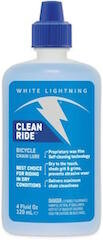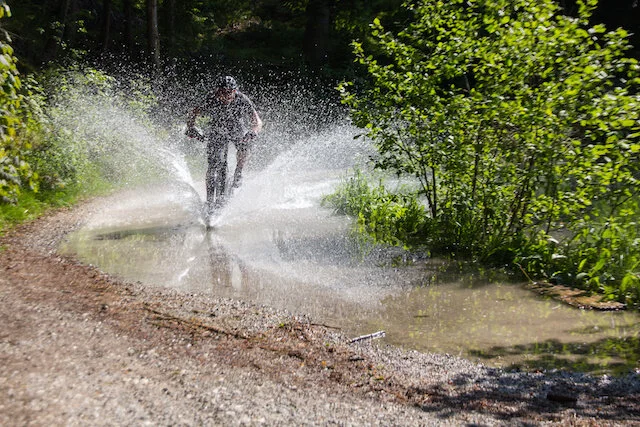What are the differences between wet and dry chain lubricants for mountain bikes?
Wet lube goes on wet and stays wet, while dry lube goes on wet and leaves a clean, dry, waxy residue. Dry lubes don’t last as long and are best used in dry conditions. Wet lubes stay on significantly longer, even while riding in inclement conditions.
Dry Chain Lubricant
Dry Lubes:
Best for dry environments
Non-tacky
Low viscosity (dry) - Doesn’t hold on to dust & grit
Waxy
The general rule of thumb = summer riding
Dry lubricant DISADVANTAGES:
Usually take a couple of hours to dry, which means can’t just lube in the parking lot and roll out for a ride
Doesn’t last long on the chain = more frequent applications
Chain needs to be clean before application
Doesn’t flow back over areas that lost lubrication after the dry lube flakes off.
Generally is more expensive
Dry lubes, also called solid lubricants go on wet and dry for 2-4 hours, resulting in a dry chain.
A solid/dry lubricant is a lubricant that uses special materials in the formula to provide a protective layer against dust and dirt.
Most dry lubricants are made with a paraffin wax or teflon base and then suspended in a liquid or solvent that allows them to flow between the chain pins and rollers. Molybdenum disulfide (MoS2) or graphite are added to the mix in some dry lubes, which was part of the original dry lubricant formula of the 1940s.
The majority of dry lubes require more frequent application, and if you do happen to ride in rainy or wet conditions, make sure you re-apply after riding since all your lube will have been washed off.
When to use dry lubes
My buddy Sean biking in Moab….with dry lube
Dry lubes are best used in dry environmental conditions since it’s thin and waxy, which prevents dust, sand, and dirt from sticking to the chain. If you do most of your riding in sunny summertime conditions, and avoid trail riding during inclement weather, then dry lube is ideal. Also, if you cycle or MTB in dry, desert places, such as Moab or Grand Junction then dry lubes will work just fine.
Dry lubes wash off very easily, which means hitting any stretch of wet trails or riding through a surprise rainstorm will leave your chain void of any lubricant. Just like wet lube, dry lube is made of oil and anti-friction compounds.
Mountain bikers that like to clean and service their bike regularly and ride predominantly in dry and favorable weather conditions are best suited to using dry lubes. Since dry lube is not durable, more frequent applications are necessary, also the chain needs to be very clean when applying.
wet chain lubricant
Wet lube:
Good for wet, muddy, humid conditions
Stays on chain much longer
less reapplications
longer rides
Allows the MTB to be used while not optimally clean more effectively
Don’t need time to dry, so can just reapply as needed on the spot
General rule of thumb = winter riding
Wet lubricant DISADVANTAGES:
Holds on to more dirt and grime
In wet and rainy conditions wet lubricant works well because it’s thick and sticky, which allows the lubricant to stick to the chain despite the rain splashing on the lube.
When to use wet lubes
If you ride long distances and enjoy biking in all weather conditions then wet lube would be a good choice for you. This lube lasts longer and doesn’t get washed off from rain or splashed off from puddles.
If you don’t enjoy frequent lube application or forget to lube your MTB chain, wet lube is probably your best option, since wet lubes last much longer, and doesn’t require time to dry upon re-application.
If you ride in wet conditions, wet lube has a tendency to collect dirt and grit, so its a good idea to clean your bike after riding.
What is Main difference between wet & dry lube
What’s the main difference between a wet and dry lubricant?
Wet lubes don’t attract dirt, but rather holds the dirt. However, wet lubes will suspend the grit particles, so they are not actually coming into contact with your drivetrain
Dry lubes don’t hold dirt. As dirt and grime hits the dry lubricant, parts of the dry lube, along with the grit fall to the ground. As these grit/lube particles fall to the ground your chain is losing lube, but keep the grit from entering the drivetrain
what does chain lube do?
Chain lubrication reduces the wear of the drivetrain components and decreases the amount of force required by the rider to pedal.
A chain that is covered in dirt and grit, even minute mineral particles, act as a file on the cogs, chain, and chainrings, which results in wear and tear, and decreased drivetrain pedal efficiency. Both dry and wet lubricants keep grit particles from coming in contact with your chain, thus lowering the abrasivity of your chain.
(Image Source)
Dry or wet lube: Which one is better?
Dry lube was developed in the 1940s as moving parts become more advanced and needed to operate and move at high temperatures. As aircraft and rockets were being developed, these types of machines needed more heat resistant lubricants. Dry lubes lubricate at high temperatures and low pressures and do not evaporate in super hot environments.
Generally, dry lubes are known to have higher coefficients of friction, which translates to decreased pedal efficiency. However, finding valid studies that compare bike-specific dry lubes to wet lubes is presently not available. Most manufactures of lubricants use proprietary formulas and keep their research and studies private.
Wet lubes lubricate in all-weather conditions, offer better pedal efficiency, and last longer. Does that make wet lubes better??? Not necessarily. Dry lubricants don’t pick up as much trail debris, which outweighs all the combined benefits of wet lubricants…..exempting biking in inclement weather.
what is a universal/all-season lubricant?
A quality universal lube should use a wet lubricant base with dry lubricant additives, plus ester oils, which helps the lube stick to the metal chain.
However, since proprietary blends don’t list the specific ingredients, it’s possible that a less viscous, or thinner wet lube could be used, and marketed as a universal lubricant. Thin lubricants don’t hold as much dirt and are mildly resistant to wash out from rain.
What is the best chain lube?
The bicycle transmission for nearly a century has run at 99% efficiency, which is well before all the bicycle-specific lubricants.
The chain and drivetrain are the dirtiest parts of your MTB, as these parts are lowest to the ground and unprotected.
Cleaning your chain after exposure to mud, water, clay, and other trail debris is significantly more important for your drivetrain performance and life, than what type of lubricant you use.
A dirty drivetrain doesn’t even operate at 90% efficiency. This means the best chain lubricant is worthless, unless it’s operating under perfect conditions.
final thought
Many riders and cyclists debate about what is the best type of chain lube based upon climatic factors and other variables.
However, for the average recreational MTBer/cyclists, the two most important things are keeping your chain clean and lubricated. This will result in a longer-lasting chain that will pedal easily and smoothly, regardless of what type of lube you use.
Jesse is Director of Pedal Chile and lives in La Patagonia. Jesse has a Master of Science in Health and Human Performance and is an avid MTBer, reader of all things non-fiction, and loves Belgian beers.

















